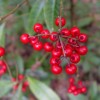 Coral ardisia, also known as coral berry, spice berry, and scratchthroat, was introduced to Florida in the early 1900’s for ornamental purposes. Since then, it has escaped cultivation, and it is found in hardwood hammocks and other moist, natural-wooded areas and grazing lands. Although there is no published literature supporting the theory that coral ardisia is toxic, it is suspected that the berries and/or foliage are poisonous to livestock, pets, and humans. This 3-page fact sheet was written by B. A. Sellers, Sarah Lancaster, K. A. Langeland, J.A. Ferrell, Michael Meisenberg, and J. Walter, and published by the UF Department of Agronomy, November 2013.
Coral ardisia, also known as coral berry, spice berry, and scratchthroat, was introduced to Florida in the early 1900’s for ornamental purposes. Since then, it has escaped cultivation, and it is found in hardwood hammocks and other moist, natural-wooded areas and grazing lands. Although there is no published literature supporting the theory that coral ardisia is toxic, it is suspected that the berries and/or foliage are poisonous to livestock, pets, and humans. This 3-page fact sheet was written by B. A. Sellers, Sarah Lancaster, K. A. Langeland, J.A. Ferrell, Michael Meisenberg, and J. Walter, and published by the UF Department of Agronomy, November 2013.
http://edis.ifas.ufl.edu/ag281
Tag: Michael Meisenburg
SS-AGR-309/AG315 Japanese clematis, Clematis terniflora (D.C.) Ranuculaceae
SS-AGR-309, a 4-page illustrated fact sheet by Michael Meisenburg, Ken Langeland, and Kurt Vollmer, describes this vigorous woody vine that is recommended for landscape use in cold-hardy zones, but is considered invasive in many areas of the country — its impacts and management. Includes references. Published by the UF Department of Agronomy, September 2008.
http://edis.ifas.ufl.edu/AG315